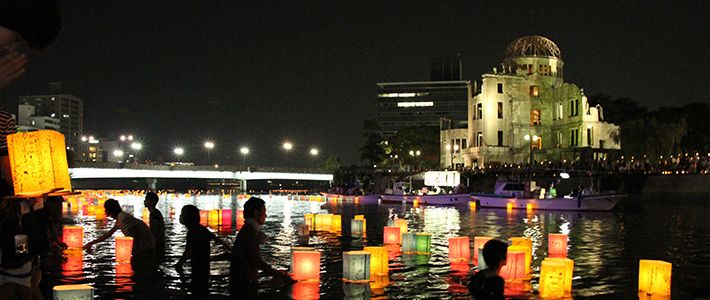
Hiroshima and Nagasaki Revisited
New Meaning for Hiroshima's Antinuclear Crusade
Politics Society- English
- 日本語
- 简体字
- 繁體字
- Français
- Español
- العربية
- Русский
The Growing Threat of Proliferation
The ranks of atomic bomb survivors at the annual Peace Memorial Ceremony in Hiroshima have dwindled year by year as age and infirmity gradually claim Japan's remaining hibakusha, whose average age is now 78. Increasingly, younger Japanese and visitors from abroad are stepping in to fill the gap. Among the highlights this past summer was an appearance by American film director and academy award winner Oliver Stone, who made his first visit to Hiroshima. Also on hand to hear Hiroshima's annual plea for the abolition of nuclear weapons were officials from 70 countries worldwide (including Britain, France, Russia, and the United States) and from the European Union and the United Nations.
Close to 70 years have passed since atomic bombs leveled Hiroshima and Nagasaki, but the pull of those cities remains strong, and their message is as relevant as ever. The Cold War may have ended, but the nuclear threat remains very real.
Today the world's combined nuclear arsenal amounts to roughly 17,000 nuclear weapons. While the bulk of these are concentrated in the United States and Russia, proliferation is an ongoing concern. India, Pakistan, and Israel—all known to possess nuclear weapons—have refused to sign the Treaty on the Non-Proliferation of Nuclear Weapons (NPT); North Korea, a self-avowed nuclear power, has withdrawn from the NPT; and Iran's noncompliance has raised alarm throughout the international community.
The more nuclear power plants spring up around the world, the more countries gain access to fissile materials and nuclear technology. We have already seen such materials and technologies diverted for military purposes, and the possibility of nuclear terrorism by some militant group is no longer a far-fetched scenario. Although the threat of global nuclear war may have receded since the Cold War era, the potential for a limited nuclear conflagration, whether planned or accidental, is higher than ever.
The 2009 Hiroshima-Nagasaki Declaration
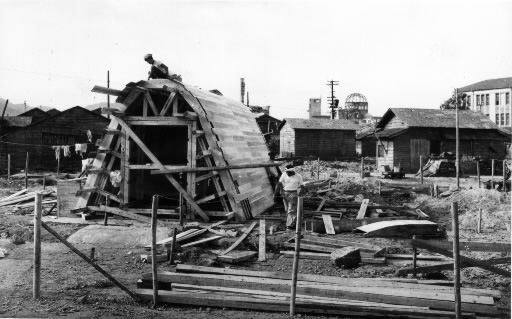 Memorial Cenotaph for A-bomb victims under construction in May 1952, in what is now the Hiroshima Peace Memorial Park. In the background, the Atomic Bomb Dome rises over the roofs of shacks built on the city's ruins.
Memorial Cenotaph for A-bomb victims under construction in May 1952, in what is now the Hiroshima Peace Memorial Park. In the background, the Atomic Bomb Dome rises over the roofs of shacks built on the city's ruins.
In 2009, a group of 17 Nobel peace laureates—including former President Kim Dae-jung of the Republic of Korea and the late Wangari Maathai of Kenya—gave voice to this sense of crisis in the Hiroshima-Nagasaki Declaration, an appeal to the world's leaders and citizens to abolish nuclear weapons. On May 17, 2009, the declaration was carried in the Hiroshima-based newspaper the Chūgoku Shimbun and posted on the newspaper's Hiroshima Peace Media Center, a bilingual (Japanese and English) website dedicated to information about the atomic bomb and advocacy for peace and the abolition of nuclear weapons.
The declaration signed by the Nobel peace laureates articulates a clear choice: "We can either put an end to proliferation and set a course toward abolition," it says, "or we can wait for the horrors of Hiroshima and Nagasaki to be repeated." It goes on to quote the great physicist Albert Einstein: "The unleashed power of the atom has changed everything save our modes of thinking, and we thus drift toward unparalleled catastrophe," Einstein wrote in 1946. "We shall require a substantially new manner of thinking if mankind is to survive." And it concludes with an appeal for action by the citizens of the world: "Eliminating nuclear weapons is indeed a possibility. . . . Humanity must stand together to make this vision a reality."
Printed in many of Japan's local and regional papers and reported by the Huffington Post, one of America's leading online news sources, the Hiroshima-Nagasaki Declaration has had a far-reaching impact in Japan and around the world.
Contemplating the End of Human Civilization
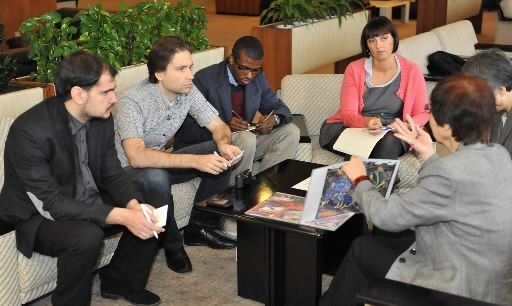 Journalists from Britain, the Czech Republic, Denmark, and Romania interview an atomic bomb survivor in Hiroshima in November 2012. The international media have helped the hibakusha tell their stories and broadcast their antinuclear message around the world.
Journalists from Britain, the Czech Republic, Denmark, and Romania interview an atomic bomb survivor in Hiroshima in November 2012. The international media have helped the hibakusha tell their stories and broadcast their antinuclear message around the world.
The United States developed the atomic bomb near the end of World War II and put the new weapon to use in attacks on Hiroshima and Nagasaki in August 1945. The bombs unleashed unparalleled destruction from blast effects, thermal radiation, and finally the effects of residual nuclear radiation, for which nuclear weapons are uniquely notorious. Under the rising mushroom cloud tens of thousands were slaughtered indiscriminately, irrespective of nationality, ethnicity, or religion: women, children, the elderly, Allied prisoners of war, and Korean nationals along with Japanese soldiers.
Hiroshima had about 327,000 permanent residents at the time, but the presence of military personnel boosted the total population to about 350,000. By the end of 1945, an estimated 130,000 to 150,000 had died as a result of the bomb. In Nagasaki, about 74,000 died out of an estimated population of 240,000.
For the survivors who experienced and witnessed the devastation caused by a single nuclear explosion, the ruined cityscape seemed to prefigure the end of human civilization. It is a sentiment that comes through loud and clear in the original Peace Declaration, delivered by Hiroshima Mayor Hamai Shinso (1905–68) at the first Hiroshima Peace Festival in 1947, when the city's reconstruction had barely begun: "This horrible weapon brought about a 'revolution of thought,' which has convinced us of the necessity and the value of eternal peace," Mayor Hamai declared. "That is to say, because of this atomic bomb, the people of the world have become aware that a global war in which atomic energy would be used would lead to the end of our civilization and extinction of mankind. This revolution in thinking ought to be the basis for an absolute peace, and imply the birth of new life and a new world."
That ceremony, held in the midst of hastily built temporary dwellings, has continued to the present day as the annual August 6, Peace Memorial Ceremony, and each subsequent mayor of Hiroshima has used the occasion to issue a Peace Declaration.
Hiroshima, City of Death and Rebirth
During World War II, Hiroshima was a regional command center and supply depot for the Imperial Army. As a result of its devastating wartime experience, culminating in the atomic bombing, it was reborn as a city dedicated to peace.
The reconstruction was made possible by the Hiroshima Peace Memorial City Construction Act, passed by the National Diet in 1949 and promulgated on August 6 of the same year, following its overwhelming approval in a local referendum. The law paved the way for the construction of Hiroshima Peace Memorial Park, including the Memorial Cenotaph for A-bomb victims and the Peace Memorial Museum, as well as an ambitious redevelopment plan aimed at turning Hiroshima into an "international city of peace and culture." As a result, Hiroshima has indeed been reborn, but the road to recovery and reconstruction was long and arduous. As late as the 1970s, shacks and makeshift shelters littered the area along the river just north of the Atomic Bomb Dome.
The hibakusha who survived the bomb and its aftermath overwhelmingly described the experience as "a living hell." Their physical and psychological wounds, unlike the city's physical infrastructure, would never fully heal. They could never know when the damage from of radiation exposure might surface in the form of cancer, or how it might affect their children. In addition to illness and constant anxiety, they faced widespread prejudice and discrimination in matters ranging from marriage to employment. Still, as time went on, many were able to transcend their suffering, conquer their bitterness toward the perpetrators of the attack, and find meaning in sharing their stories, in hopes of preventing a similar tragedy from ever occurring again.
A Justifiable Nuclear Phobia
The experience of Hiroshima and Nagasaki instilled in the Japanese people an understandable horror of nuclear weapons. Their antinuclear sentiment received reinforcement from an incident in March 1954, when fallout from a US nuclear test on Bikini Atoll poisoned the crew of Japanese fishing vessels, including the Daigo Fukuryū Maru.
Ironically, 1954 was also the year the Japanese government launched an aggressive nuclear energy program. The government's ambitious policy of exploiting nuclear energy for peaceful purposes met with surprisingly little opposition from Japanese citizens, despite their hatred of nuclear weapons. Many Japanese nuclear scientists portrayed nuclear power as an ideal energy source with the potential to usher in an era of peace and prosperity—and for the most part, those of us in the media went along. The hibakusha were no exception to this trend, notwithstanding their personal experience with radioactive contamination. Efforts by the United States and other countries to encourage Japan to develop nuclear energy, based on the argument it was clean, safe, and affordable, met with little skepticism. Although the Japanese people overwhelmingly opposed the use of nuclear fission for military purposes, most saw no problem with using it ethically for strictly peaceful ends.
All that changed after March 11, 2011.
The Fukushima Nuclear Disaster
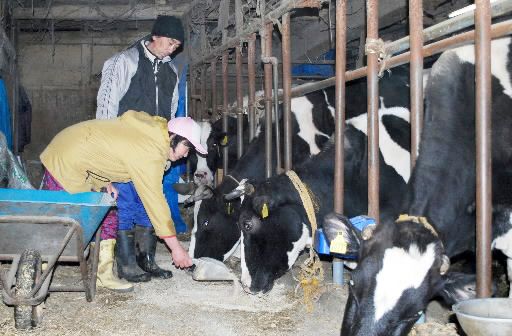 One month after the nuclear meltdown at the Fukushima Daiichi nuclear power plant, Harada Sadanori and his wife Kimiko feed their dairy cows before bidding farewell to their livestock and their livelihood. High levels of radioactivity forced the evacuation of the entire village of Iitate, located 40 kilometers from the site of the accident.
One month after the nuclear meltdown at the Fukushima Daiichi nuclear power plant, Harada Sadanori and his wife Kimiko feed their dairy cows before bidding farewell to their livestock and their livelihood. High levels of radioactivity forced the evacuation of the entire village of Iitate, located 40 kilometers from the site of the accident.
On March 11, 2011, a catastrophic nuclear accident took place at the Fukushima Daiichi nuclear power plant following a massive earthquake and tsunami along the northeastern coast of Japan. Several of the plant's reactors melted down, and explosions released large amounts of radioactive material into the atmosphere.
Until then, very few hibakusha had even broached the subject of nuclear power in their interviews or public appearances. Most of them placed nuclear power in a completely different category from nuclear weapons. Not even the Chernobyl disaster of 1986, which spewed radioactive contamination over most of the Northern Hemisphere, altered their thinking; they found it hard to read much significance into such a remote event. But the Fukushima disaster marked a turning point. Since then, many of the hibakusha who have told their stories have informed me that they now regret not speaking out against nuclear energy sooner.
Increasingly, they have come to see that nuclear power carries unacceptable risks to human health and the environment. Accidents like those at Chernobyl and Fukushima, in which a nuclear reaction spins out of control, have a profound, widespread, and irreversible impact on human health and on the surrounding ecosystem. Even putting aside the risk of catastrophic accidents, nuclear power raises the unresolved dilemma of how to safely store tons of toxic radioactive waste over tens of thousands of years. Meanwhile, plant workers face the threat of radiation exposure on a daily basis.
Hundreds of thousands of people were uprooted as a result of the Fukushima accident—forced to abandon their homes and farms forever. Two and a half years after the accident, those who made a living fishing off the coast are still unable to return to work. I have traveled around the region talking to such people, and their words are seared in my memory. As one put it, "After World War II the refrain was 'the nation is broken, but the land is whole.' Now the nation is prospering, but the land is ruined." A fisherman said to me, "We don't want compensation. Fishermen live to go out on the water and catch fish. As things stand now, our hopes and dreams are extinguished." The suffering and anger of these people cannot but raise the question: What did the Japanese learn from the experience of Hiroshima, Nagasaki, and the Bikini incident?
A Plea on Behalf of Hibakusha Worldwide
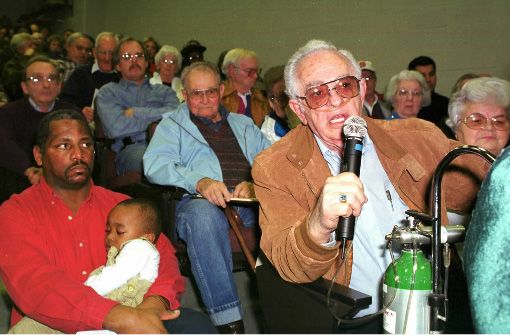 A former worker at the Savannah River Site, which produced nuclear materials for the US Army, testifies about the health effects of radiation exposure at a 2001 Department of Energy hearing in Aiken, South Carolina.
A former worker at the Savannah River Site, which produced nuclear materials for the US Army, testifies about the health effects of radiation exposure at a 2001 Department of Energy hearing in Aiken, South Carolina.
Whether the purpose is building nuclear weapons or generating electricity, the nuclear fuel cycle results in radioactive contamination and exposure at every stage, from uranium mining to spent fuel processing. The victims of radiation exposure—hibakusha, in other words—are to be found all around the world, not just in Hiroshima and Nagasaki.
The Chūgoku Shimbun, which lost 114 employees (about a third of its staff) in the 1945 A-bomb attack, published a yearlong series of articles in 1989, three years after the Chernobyl disaster, titled “Exposure-Victims of Radiation Speak Out.” The articles in the series were based on interviews and investigations at 21 locales in 15 countries, including the United States and the former Soviet Union, to expose the dangers of nuclear dependence and call for a halt to the construction of nuclear power plants.
The Memorial Cenotaph at Hiroshima Peace Memorial Park bears the inscription "Let all the souls here rest in peace, for we shall not repeat the evil.” Implicit in this inscription is the promise of no more Hiroshimas, no more Nagasakis, and no more war. Surely it should also be taken to mean "no more hibakusha."
Living and working in Hiroshima, with its grim history, we at the Chūgoku Shimbun have naturally come to view nuclear arms not as instruments of power but as weapons against humanity, the bearers of devastation and indescribable suffering. This is why we have sought out and supported the hibakusha, one by one, and have recorded the history of Hiroshima in words and images. This is also the perspective from which we have covered the hibakusha of the world, whether their exposure resulted from nuclear weapons development, a nuclear accident, or some other cause.
A Legacy We Must Not Pass Down
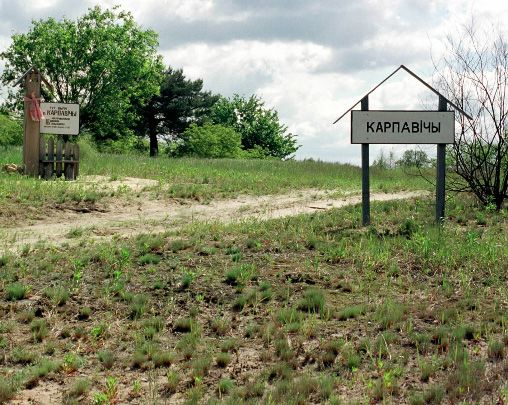 Two placards are all that remains of a village in the Gomel region of Belarus, where 185 people lived until 1987. Authorities had all 67 homes bulldozed after detecting high levels of radiation in the wake of the 1986 Chernobyl nuclear disaster (2001 photo).
Two placards are all that remains of a village in the Gomel region of Belarus, where 185 people lived until 1987. Authorities had all 67 homes bulldozed after detecting high levels of radiation in the wake of the 1986 Chernobyl nuclear disaster (2001 photo).
Thanks to the determined efforts of hibakusha to get their message out over these many years, more and more people around the world are coming to the view nuclear arms not as a practical instrument of power but as an unequivocal evil. Now public opinion is also turning against nuclear power and demanding a shift toward safe, renewable, and sustainable energy sources. The citizens of the world will not permit the bitter legacy of the nuclear age to be passed down to yet another generation.
Surely the most realistic hope for resolving the problems plaguing the world today (including the bitter legacy of the nuclear age) and securing a future for the human race lies not in reliance on ever greater military might and more powerful weapons but in coexistence with our fellow human beings, harmony with nature, respect for human life, and tolerance of diversity. This is the ideology enshrined in the Japanese Constitution, and it is also the philosophy of Hiroshima and Nagasaki, born of their tragic experience. At the Chūgoku Shimbun, headquartered in the heart of Hiroshima, we will continue to uphold these principles and work tirelessly for a peaceful, nuclear-free world.
(Photos courtesy of the Chūgoku Shimbun Co., Ltd.)
▼images
World Heritage: Hiroshima Peace Memorial (Genbaku Dome) (360° Panorama)
Fukushima Nagasaki Hiroshima atomic bomb Peace Memorial Park NPT